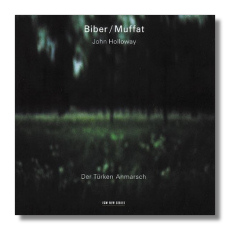
The Internet's Premier Classical Music Source
Related Links
- Biber Reviews
- Latest Reviews
- More Reviews
-
By Composer
-
Collections
DVD & Blu-ray
Books
Concert Reviews
Articles/Interviews
Software
Audio
Search Amazon
Recommended Links
Site News
 CD Review
CD Review
Heinrich Ignaz Franz von Biber

Der Türken Anmarsch
- Sonatae Violino Solo #1 in A Major
- Sonatae Violino Solo #2 in D dorian
- Sonatae Violino Solo #5 in E minor
- Sonatae Violino Solo #8 in A Major
- Sonata "Victori der Christen" in A minor
- Georg Muffat: Sonata Violino Solo in D Major
John Holloway, violin
Aloysia Assenbaum, organ
Lars Ulrik Mortensen, harpsichord
ECM New Series 1837 472432-2 DDD 62:52
An early example of program music can be found in the "Victori der Christen" Sonata by Heinrich Ignaz Franz Biber (1644-1704). In 1683, Turks attacked Vienna, and the sonata's several sections depict the Turkish advance, siege, and assault on the city, and the response of Christian forces, leading to the expulsion of the invaders. An imaginative listener might claim to hear not just battle music but also cultural stereotypes in this sonata. However, before making that claim, he or she should know it is unlikely that Biber had any such program in mind when he actually wrote this work. Instead, the "Victori der Christen" (Christian Victory) Sonata appears to have been adapted from Biber's music by Johann Heinrich Schmelzer, a Viennese contemporary of the Salzburg-based Biber. (Biber's original sonata was part of a series in which Christ's passion was represented, but that is a different story.)
Until recently underrepresented on disc, Biber's music is both sensually appealing and historically important. Almost two generations before Vivaldi and Bach, Biber developed the violin as a solo instrument capable of both virtuoso display and emotional expression. An earlier ECM New Series release with the present musicians ("Unam Ceylum"- ECM New Series 1791 472084-2) drew from Biber's seminal Sonatae Violino Solo; the present disc includes four more sonatas from that collection, in addition to the one described above. As on the earlier disc, the violin is supported by a basso continuo comprised (unusually) of organ and harpsichord. Even when it is not programmatic, Biber's music is vivid and often pictorial. And even though it is virtuosic, it doesn't descend into series of busy but meaningless figurations – a trap that composers two centuries later were not always safe from falling into! Suspensions, passing dissonances, and feats of unexpected harmonic trickery add to the emotional intensity, but these sonatas have a fundamental seriousness and structural rigor to them as well. Hearing them is like touring the interior of a sumptuously appointed but strong-lined Gothic cathedral.
Georg Muffat was Biber's contemporary. The sonata offered here was written in Prague in 1677. Similar in style to Biber's sonatas, it is remarkable work for a composer who was only 24 at the time.
This is the third ECM New Series disc for these three musicians, and their second devoted to Biber. Assenbaum recently succumbed to a long illness, and so this CD is something of a memorial to her. She and Mortensen provide Holloway with atmospheric and stylistically informed support. Holloway, playing on either an instrument of Biber's time, or on a modern reproduction – ECM's booklet does not say – plays with the understated intensity that one expects from any musician recording on this label. Appropriately, an Austrian monastery (St. Gerold) was the site for this 2002 recording.
Copyright © 2005, Raymond Tuttle



















